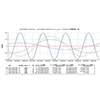Open Platform Communications Unified Architecture (OPC UA)
An international standard for a safe and highly reliable information communication infrastructure for industrial communication that enables data exchange between products from different vendors and between different platforms (operating systems, programming languages, data formats). OPC UA is a standard that is expected to support the automation of various devices and the realization of smart factories.
- Standardization of specifications and data linkage between devices that differ depending on the vendor
- A new international standard that supports the linkage of systems in a wide range of industrial fields
- Adopted as an Industry 4.0 standard and used for smart production

Standardization of specifications and data linkage between devices that differ depending on the vendor
In factories, various manufacturing equipment, control devices, and systems are linked to achieve an automation system that supports production activities. The equipment and systems that make up an automated system usually consist of products made by multiple vendors, and the procedures and specifications for exchanging data are generally different for each vendor. Therefore, to link data between these different devices and systems, the creation of linking programs has been necessary. Naturally, this requires considerable labor and cost.
To solve the problems related to data linkage, OLE for Process Control (OPC) was created in 1996 with the cooperation of manufacturing machine and control equipment vendors and the manufacturers that use their products. If the interface mechanism for data integration built into each vendor’s equipment and system complies with OPC, there is no need to create a separate program for connection, and data interoperability between products from multiple vendors is possible.
A new international standard that supports the linkage of systems in a wide range of industrial fields
However, starting in the 2000s, the equipment and systems at factory sites were required to link not only within the automation area of the factory, but also with other production bases, with corporate headquarters, and with systems in a wider range of industrial fields, which gave rise to problems with OPC.
For example, OPC was based on Microsoft’s data exchange mechanism, Object Linking and Embedding (OLE), so its use is limited to a Windows platform. In order to achieve data linkage beyond the framework of a factory, it was necessary to create a system that could be used on various platforms, not just Windows.
So instead of OLE, a technology called service oriented architecture (SOA)※1 that inherited the data interoperability of OPC was adopted, and Open Platform Communications Unified Architecture (OPC UA) was created as an international standard. In OPC UA, the requirements of connection, communication, and safety, which were identified as the basic principles of data interoperability by the OPC Foundation, have been comprehensively incorporated. The OPC Foundation has led the formulation of the standard since the old version of OPC (OPC Classic).
First of all, regarding connection, OPC UA is based on the above-mentioned SOA and supports various platforms, including Windows and Linux, as well as iOS and Android installed on devices such as smartphones and tablets. Applications that use OPC UA can be built without dependence on an OS or programming language.
Regarding communication, in OPC UA, rules are established for defining metadata for each field or application. Metadata tells the meaning of the data that is actually exchanged, so that, for example, the user can store data on temperature in one place and data on pressure in another.
Furthermore, regarding safety, in recent years various systems are interconnected by networks. These are not only general IT systems, but also operational technology (OT) systems, such as manufacturing machine and factory control systems. In this environment the danger of cyber attacks is increasing. When OPC UA is used, however, the general security countermeasure technologies used in the IT world, such as encryption, authentication, and digital signatures, are available.
Adopted as an Industry 4.0 standard and used for smart production
Today, with the proliferation of Industrial Internet of Things (IIoT) initiatives, production sites and a wide range of systems and devices in industry are being connected to networks. The OPC UA concept of platform-independent safe information interoperability has won support in various fields.
An example is Industry 4.0,※2 which originated in Germany. The trend toward smart production sites using digital technology such as IIoT and Artificial Intelligence (AI) is spreading on a global scale. OPC UA has been adopted as a standard approach for data linkage in Industry 4.0.
To support the accelerating flow of networking and digitization in manufacturing and else where in the industrial sector, OPC UA is expected to play an increasingly important role.
※1: Service Oriented Architecture (SOA) The idea of building an IT system by implementing computer software functions in independent “services” and combining those services. ※2: Industry 4.0 Also called the Fourth Industrial Revolution, this technological concept aims at automation, digitization, and computerization of the manufacturing industry. The Internet of Things (IoT) and cloud computing are part of Industry 4.0.


